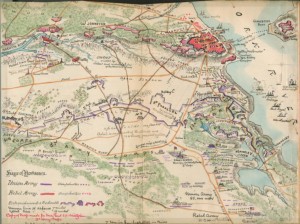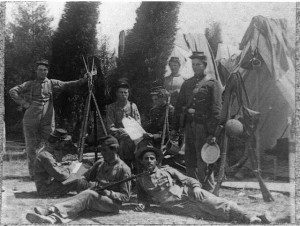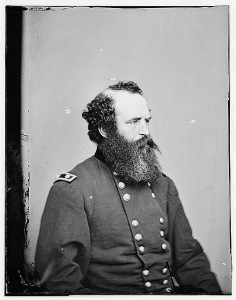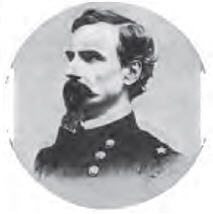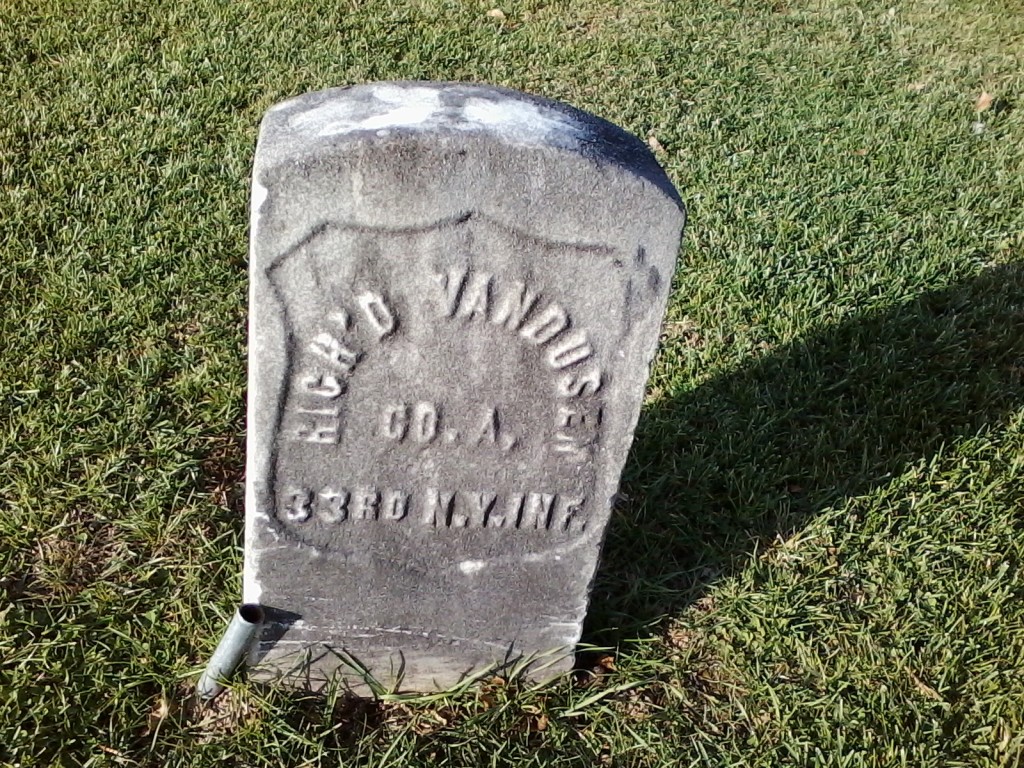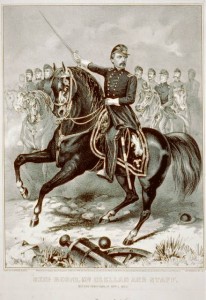From a Seneca County, New York newspaper in 1862:
Letter from Lieut. Brett.
Camp Near Yorktown, Va.
April, 11th 1862.
Since I last wrote, we have had some pretty sharp fighting. Our brigade thus far has done all the skirmishing for the entire corps, and the gallant 33d took the lead of the Brigade in the advance, clear up to line of the enemy’s fortifications, which now temporarily impede our march “on to Richmond.” I am happy to say that our boys face the music with as much coolness and unconcern as would have done honor to Napoleon’s Old Guard. On Saturday we were marched in line of battle up to within 500 yards of one of the rebel forts, and were kept there till dark as a support for four field pieces while they tried to see what the enemy were made of. The shells went flying over our heads in every direction. Our guns shot away their flag staff twice during the skirmish, and you ought to have heard them yell every time our shells burst among them. Had they not thrown their shells so very high, hundreds would have been killed in our Brigade. As it was but two of our men were killed, and four or five wounded. One poor fellow was killed by a shell, which passed right through his body.
What you said about the Old Banner made me feel quite patriotic, for I had retained the one which we brought out with us, sometimes carrying it on my back in my knapsack, and sometimes in my bosom, for we had to leave all our trunks and baggage when we got orders to march the last time, and even the officers had to carry their blankets and rations, and I did’nt know but I might perhaps have occasion to raise the noble old emblem upon the enemy’s works during the war.
But to go on with my story. We were kept within a short distance of the enemy all that night. Next day our company was placed on the right of the guns and our first platoon was deployed out at intervals, right in front of two of the forts, in full view of the rebels to act as skirmishers, and telegraph anything they might see to Gen. Davidson. The rebel battery had been silenced the day before but they favored us with an occasional shell. One struck a limber within six rods of my 2d platoon, and all of the cartridges attached to the shells in the limber exploded, blowing it to atoms. It contained forty-five shells and most of the fuzes were ignited, but some one with a good deal of presence of mind, after the first one exploded caught up a bucket of water which the gunner had used to wet his swab in, and threw on them, and prevented further disaster. This was a fortunate escape, as the gunners as well as our boys had time to throw themselves upon their faces and not a man was injured. the rebels jumped upon the parapet, yelled and danced at the prospect, undoubtedly, of a great extermination of the Yankees. They soon changed their tune, however, for Capt. Ayres sent four shells, one after another, among them, which seemed to settle their tea for that day.
There is a marsh which extends for miles in front of the rebel fortifications, and in front of us. It is about 200 yards in width. Capt. Guion had Co. A., deployed to the left of the fort in front of a rifle pit, very near the marsh, and within speaking distance of the enemy. At intervals, or whenever they stopped shooting at each other, they kept up a conversation with the rebels. This placed our humorous friend, Dick Van Dusen right in his element, and he got off some pretty good things at the expense of our chivalrous Southern friends. They called us all sorts of hard names. One fellow asked if we had any wooden nutmegs to sell. At this one of our boys sent a bullet among them, with the remark that there was one, asking how they liked it. Our boys kept themselves covered so well by the trees that none were injured, but the enemy were seen to carry several who were either killed or wounded.
Young’s Mills we took a week ago without firing a shot. I went through all through the batteries and barracks in order to find some trophy to send you, but could find nothing except a few Georgia newspapers too old to send home.
Our camp is now about a mile from the enemy, back in the woods. On Monday while standing in the rain almost in sight of the rebel breastworks, I saw Gen. Smith, commander of our Division, Gen. Keyes, commander of our Corps, and another person dressed as a private, in earnest conversation, who I at once recognized as Major-General GEO. B. MCCLELLAN. The last named gentleman gave us to understand, I afterwards ascertained, that we were getting into close quarters, and ordered the main part of our forces back, leaving nothing but a picket, till we were better prepared to occupy a position nearer the enemy.
Wednesday night at 12 o’clock I was sent with 30 men to release the picket, precisely where Capt. Guion was on Sunday, with strict orders to keep the men from exposing themselves. I had all I could do to prevent [appears a word was missing in newspaper article] from doing so. As daylight began to make its appearance, the enemy on the other side of the water opened the ball by crowing like so many cocks, all along the line. Upon hearing this our boys immediately opened their cartridge boxes. One of the rebels finally cried out, “halloo, you Abolition Yankees over there, wake up!” This was responded to by our side by some one saying, “I am sorry I cant come over there and bid you good morning,” and with that he sent a bullet, saying “There is my card.” – Secesh immediately cries out that he shot too high, and a little far to the left. And so matters went on with an occasional exchange of shots till 11 o’clock, when we were released. More anon.
R.H. BRETT.
It is said that Robert H. Brett re-enlisted in 1863 with the rank of captain. He was shot in the lungs and killed at Newtown, Virginia on May 30,1864. He is buried in Waterloo, NY.
The New-York Times’ BUFFALO correspondent also wrote a letter 150 years ago today that substantiates much of what Lt. Brett wrote about the work of John Wynn Davidson’s brigade, including the fall back on Monday, April 7th.

